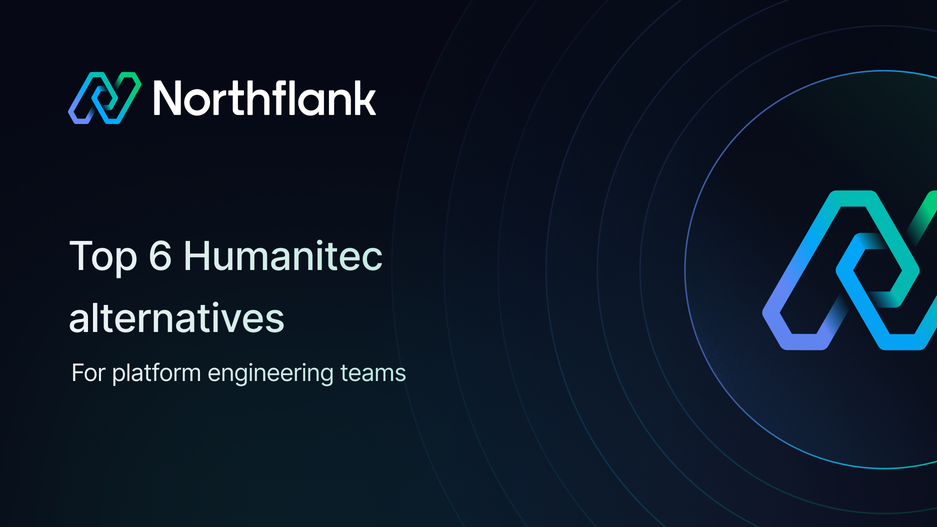

Top 6 Humanitec alternatives for platform engineering teams in 2025
Platform engineering teams building Internal Developer Platforms face a critical decision: which platform orchestrator or IDP solution will best serve their organization's needs?
While Humanitec offers platform orchestration capabilities, understanding the available alternatives helps you make an informed choice.
This guide covers six alternatives to Humanitec, comparing their technical approaches, deployment models, and ideal use cases to help you find the right fit for your team.
-
Northflank – Complete unified platform that delivers production-ready infrastructure immediately.
Unlike Humanitec's orchestrator-only approach, Northflank provides the full stack from build to deployment to observability, with zero YAML maintenance. Works across any cloud with a true Bring Your Own Cloud (BYOC) feature (deploying in your own VPC). Deploy apps, databases, jobs, and GPU workloads through a single interface in minutes.
-
Backstage – Open-source developer portal framework for service catalogs and documentation. Requires dedicated engineers to build and maintain.
-
Port – No-code internal developer portal with customizable blueprints.
-
Cortex – Commercial developer portal for service ownership and standards enforcement with scorecards and metrics.
-
Crossplane + ArgoCD – Open-source GitOps stack managing infrastructure as Kubernetes resources. Requires deep Kubernetes expertise.
-
meshStack – Enterprise cloud foundation platform for multi-cloud governance, compliance, and account management.
Platform orchestrators and developer portals solve different problems in your Internal Developer Platform architecture.
A platform orchestrator is the backend engine that coordinates infrastructure provisioning and configuration management. It generates application and infrastructure configurations dynamically with every deployment, enforcing standards across teams and workflows.
An internal developer portal is the frontend interface where developers discover services, access documentation, and trigger self-service actions.
Top-performing engineering organizations often combine both: a platform orchestrator handling backend automation with a developer portal providing the user interface.
However, modern platforms like Northflank integrate both concerns into a unified solution, removing the need to connect multiple tools.
When assessing alternatives to Humanitec, look out for these technical and organizational factors:
- Architectural approach – Does the solution provide complete platform capabilities or just orchestration? Humanitec requires you to build the developer interface and integrate existing tools. Some alternatives, like Northflank, offer unified platforms with everything included.
- Time to production – How quickly can your team deploy production workloads? Setup complexity varies significantly, from 30 minutes to six months, depending on the solution.
- Workload support – What types of workloads does the platform handle natively? This includes applications, databases, scheduled jobs, GPU workloads, and other compute types your team needs.
- Cloud strategy alignment – Does the platform support your preferred cloud providers and deployment models? Assess multi-cloud capabilities and determine if you need Bring Your Own Cloud (BYOC) functionality.
- Developer experience – Will your developers adopt this platform? The best technical platform is useless if it sits unused. Consider interface quality, learning curve, and workflow integration.
- Maintenance requirements – Who maintains the platform? Open-source frameworks require dedicated engineering teams. Commercial platforms provide ongoing maintenance but vary in required customization effort.
- Configuration management – How do developers define workload requirements? Some platforms require custom specifications, others work with standard Dockerfiles, or remove YAML entirely.
- Integration ecosystem – Does the platform work with your existing CI/CD, IaC tools, and infrastructure? Determine if it orchestrates existing tools or replaces them entirely.
The following platforms represent the leading alternatives for teams building Internal Developer Platforms, each offering distinct approaches to solving platform engineering challenges.
Northflank provides a unified developer platform that delivers production-ready infrastructure immediately, without the complexity of assembling multiple tools.
Unlike Humanitec's orchestrator-only approach that requires building additional components, Northflank offers the complete stack from build to deployment to observability.
Northflank abstracts Kubernetes complexity through a single platform. You can deploy applications, databases, jobs, and GPU workloads without managing YAML configurations.
The platform handles the entire post-commit pipeline automatically. Connect your repository, and Northflank automatically builds, packages, deploys, configures TLS, and monitors, removing weeks of setup time for orchestration engines and tool integration.
Some key features Northflank offers
-
Multi-cloud and BYOC implementation:
Deploy to Northflank's managed cloud or connect your own GKE, EKS, AKS, or bare-metal Kubernetes clusters through true Bring Your Own Cloud.
Unlike solutions that simply connect to your infrastructure, Northflank delivers a fully managed platform experience inside your VPC, giving you complete control over data residency and security while maintaining developer simplicity.
-
Zero configuration overhead:
Northflank takes out YAML maintenance entirely. While Humanitec requires Score workload specifications plus resource definitions and driver configurations, Northflank works directly with Dockerfiles or buildpacks.
Visual workflows, pipelines, and templates replace manual configuration management.
-
Production-grade features included:
All essential platform capabilities come built-in: CI/CD automation, release pipelines with promotion workflows, preview environments, secrets management, monitoring and logging, autoscaling, health checks, rollbacks, and RBAC.
Access everything through a real-time UI, comprehensive API, or CLI.
When to choose Northflank
Northflank fits teams that need production infrastructure immediately rather than in months.
The platform works particularly well for organizations running containerized applications and AI/ML workloads requiring GPU orchestration, teams wanting Kubernetes power without Kubernetes complexity, and companies needing multi-cloud flexibility or Bring Your Own Cloud (BYOC) deployment while maintaining developer simplicity.
Companies like Weights scaled to serve millions of users using Northflank, running over 10,000 AI training jobs and half a million inference runs daily without managing autoscaling or spot instance orchestration.
Other companies also use Northflank as their go-to deployment platform, making it easier than connecting multiple tools while providing more capabilities than traditional PaaS solutions.
Backstage provides an open-source framework for building internal developer portals, serving as the frontend interface for service discovery, documentation, and developer workflows.
Key capabilities
- Software catalog that tracks services, components, and ownership across your organization
- Template system for scaffolding new services using organization-defined patterns
- Extensive plugin marketplace for integrating with popular engineering tools
- TechDocs for hosting documentation directly in the portal
Best for: Organizations with dedicated engineers for platform development who value maximum customization over maintenance burden and plan to use separate tools for orchestration.
Port delivers a no-code approach to building internal developer portals with comprehensive software catalogs and self-service capabilities.
Key capabilities
- Customizable blueprints for modeling data structures without coding
- No-code service catalog creation that adapts to organization-specific needs
- Self-service actions using webhook backends to trigger workflows
- Scorecard systems to enforce standards across services
Best for: Teams prioritizing no-code customization who are willing to invest time in implementation and need basic self-service workflows where flexibility in portal design is more important than immediate production readiness.
Cortex provides a commercial internal developer portal platform emphasizing service ownership and operational excellence through standards enforcement.
Key capabilities
- Service catalog integrating with numerous tools to centralize service information
- Production readiness scorecards that track compliance with organizational standards
- Initiative tracking and campaigns to drive improvement across teams
- Engineering intelligence metrics providing visibility into velocity, incidents, and deployment patterns
Best for: Organizations prioritizing standards enforcement with a budget for commercial solutions, and organizations running primarily Kubernetes-based workloads
Combining Crossplane with ArgoCD creates a GitOps-native infrastructure management solution for organizations deeply invested in Kubernetes.
Key capabilities
- Crossplane extends Kubernetes to manage infrastructure resources across cloud providers as native objects
- ArgoCD implements continuous delivery using GitOps principles
- Bi-directional reconciliation loop where Git becomes the single source of truth
- Composition framework for building abstractions and golden paths
Best for: Teams with deep Kubernetes expertise where open-source control is essential, companies willing to invest in building abstractions, and teams where GitOps is central to development philosophy.
meshStack delivers a comprehensive cloud foundation platform for large enterprises managing complex, multi-cloud environments.
Key capabilities
- Enterprise-grade cloud account management with automatic provisioning across AWS, Azure, and other platforms
- Advanced compliance and governance controls with modular landing zones
- Multi-cloud cost management and chargeback capabilities
- Developer Portal bundling GitOps pipelines with Infrastructure as Code support
Best for: Large enterprises with complex multi-cloud governance requirements where compliance and regulatory controls are critical, and teams managing large-scale infrastructure complexity.
Choosing the right Humanitec alternative depends on your specific technical requirements, team capabilities, and organizational priorities.
Determine if you need a complete unified platform or prefer assembling separate components, assess your team's capacity for building and maintaining infrastructure, and understand how quickly you need production deployment capabilities.
The most successful platform engineering initiatives start with clear requirements and an honest assessment of internal capabilities.
Next steps:
- Define your specific platform requirements and pain points
- Assess your team's available engineering resources
- Test solutions with production workloads
- Measure potential developer adoption through user feedback
- Calculate total cost including engineering time investment
Start building your Internal Developer Platform with the solution that matches your needs. Try Northflank's free sandbox or schedule a demo to see how a unified platform compares to assembling separate orchestration and portal tools.